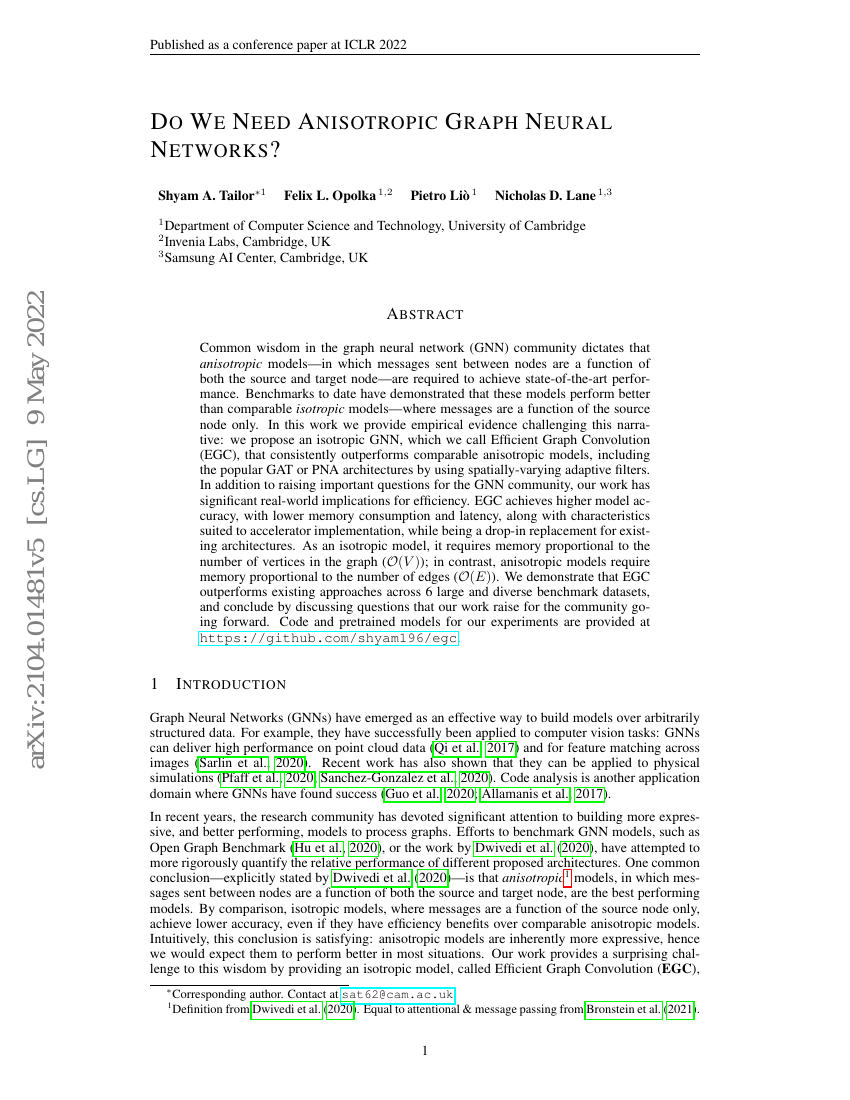Command Palette
Search for a command to run...
Shyam A. Tailor Felix L. Opolka Pietro Liò Nicholas D. Lane

Abstract
Common wisdom in the graph neural network (GNN) community dictates that anisotropic models -- in which messages sent between nodes are a function of both the source and target node -- are required to achieve state-of-the-art performance. Benchmarks to date have demonstrated that these models perform better than comparable isotropic models -- where messages are a function of the source node only. In this work we provide empirical evidence challenging this narrative: we propose an isotropic GNN, which we call Efficient Graph Convolution (EGC), that consistently outperforms comparable anisotropic models, including the popular GAT or PNA architectures by using spatially-varying adaptive filters. In addition to raising important questions for the GNN community, our work has significant real-world implications for efficiency. EGC achieves higher model accuracy, with lower memory consumption and latency, along with characteristics suited to accelerator implementation, while being a drop-in replacement for existing architectures. As an isotropic model, it requires memory proportional to the number of vertices in the graph ($\mathcal{O}(V)$); in contrast, anisotropic models require memory proportional to the number of edges ($\mathcal{O}(E)$). We demonstrate that EGC outperforms existing approaches across 6 large and diverse benchmark datasets, and conclude by discussing questions that our work raise for the community going forward. Code and pretrained models for our experiments are provided at https://github.com/shyam196/egc.
Code Repositories
Benchmarks
| Benchmark | Methodology | Metrics |
|---|---|---|
| graph-property-prediction-on-ogbg-code2 | EGC-M (No Edge Features) | Ext. data: No Number of params: 10986002 Test F1 score: 0.1595 ± 0.0019 Validation F1 score: 0.1464 ± 0.0021 |
| graph-property-prediction-on-ogbg-code2 | MPNN-Max (No Edge Features) | Ext. data: No Number of params: 10971506 Test F1 score: 0.1552 ± 0.0022 Validation F1 score: 0.1441 ± 0.0016 |
| graph-property-prediction-on-ogbg-code2 | PNA (No Edge Features) | Ext. data: No Number of params: 10992050 Test F1 score: 0.1570 ± 0.0032 Validation F1 score: 0.1453 ± 0.0025 |
| graph-property-prediction-on-ogbg-code2 | EGC-S (No Edge Features) | Ext. data: No Number of params: 11156530 Test F1 score: 0.1528 ± 0.0025 Validation F1 score: 0.1427 ± 0.0020 |
| graph-property-prediction-on-ogbg-molhiv | EGC-S (No Edge Features) | Ext. data: No Number of params: 317013 Test ROC-AUC: 0.7721 ± 0.0110 Validation ROC-AUC: 0.8366 ± 0.0074 |
| graph-property-prediction-on-ogbg-molhiv | EGC-M (No Edge Features) | Ext. data: No Number of params: 317265 Test ROC-AUC: 0.7818 ± 0.0153 Validation ROC-AUC: 0.8396 ± 0.0097 |
Build AI with AI
From idea to launch — accelerate your AI development with free AI co-coding, out-of-the-box environment and best price of GPUs.